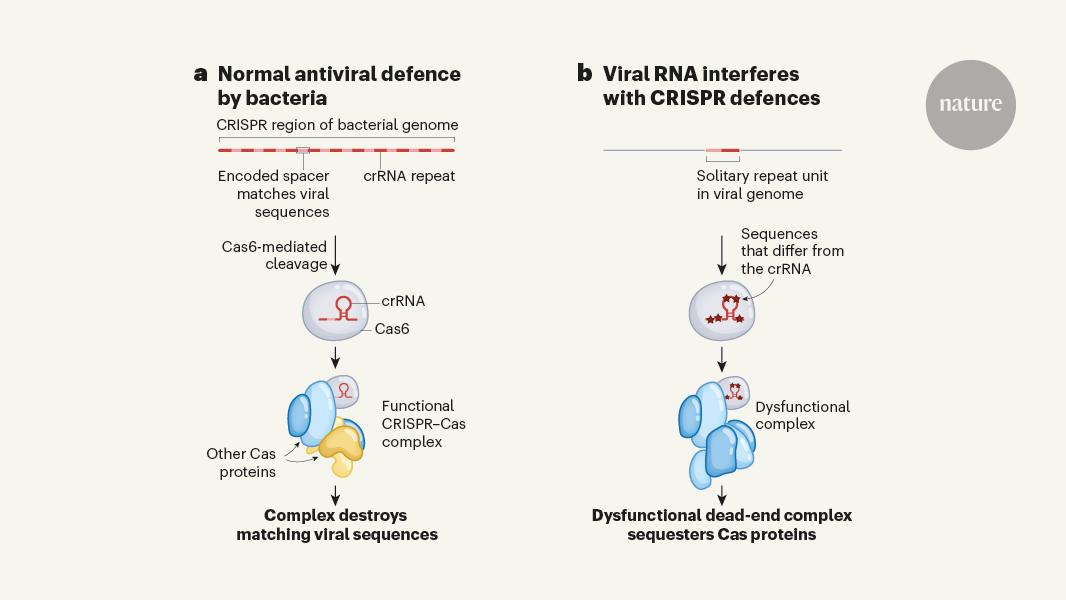
Viruses use RNA decoys to thwart CRISPR defences
- Select a language for the TTS:
- UK English Female
- UK English Male
- US English Female
- US English Male
- Australian Female
- Australian Male
- Language selected: (auto detect) - EN
Play all audios:

NEWS AND VIEWS 18 October 2023 Viruses use RNA decoys to thwart CRISPR defences Bacteria and archaea are microorganisms that often use RNA-guided defences called CRISPR to destroy the
genomes of viruses that infect them. It now emerges that viruses make RNAs that act as mimics to divert such defences. By Carolyn Kraus ORCID: http://orcid.org/0000-0001-7552-099X0 & Erik J.
Sontheimer ORCID: http://orcid.org/0000-0002-0881-03101 Carolyn Kraus Carolyn Kraus is in the RNA Therapeutics Institute, University of Massachusetts Chan Medical School, Worcester,
Massachusetts 01605, USA.
View author publications You can also search for this author in PubMed Google Scholar
Erik J. Sontheimer Erik J. Sontheimer is in the RNA Therapeutics Institute, University of Massachusetts Chan Medical School, Worcester, Massachusetts 01605, USA.
View author publications You can also search for this author in PubMed Google Scholar
Twitter Facebook Email Access through your institution Buy or subscribe Microorganisms such as bacteria and archaea flourish despite the ubiquitous presence of viruses, which are called
bacteriophages or phages, that can infect them. This resilience is partly due to the evolution of anti-phage defence systems that thwart viral infection1. Writing in Nature, Camara-Wilpert
et al.2 uncover a previously unknown strategy that viruses use to divert antiviral defences down a dead-end path.
Access options Access through your institution Additional accessoptions: Log in Learn about institutional subscriptions Read our FAQs Contact customer support
Nature 623, 490-491 (2023)
doi: https://doi.org/10.1038/d41586-023-03133-z
References Bernheim, A. & Sorek, R. Nature Rev. Microbiol. 18, 113–119 (2020).
Article PubMed Google Scholar
Camara-Wilpert, S. et al. Nature 623, 601–607 (2023).
Article Google Scholar
Barrangou, R., Sontheimer, E. J. & Marraffini, L. A. (eds) CRISPR: Biology and Applications (American Society for Microbiology Press, 2022).
Google Scholar
Li, Y. & Bondy-Denomy, J. Cell Host Microbe 29, 704–714 (2021).
Article PubMed Google Scholar
Bondy-Denomy, J. et al. CRISPR J. 1, 304–305 (2018).
Article PubMed Google Scholar
Jia, N. & Patel, D. J. Nature Rev. Mol. Cell Biol. 22, 563–579 (2021).
Article PubMed Google Scholar
Medvedeva, S. et al. Nature Commun. 10, 5204 (2019).
Article PubMed Google Scholar
Liu, C. et al. Cell Host Microbe 31, 1481–1493 (2023).
Article PubMed Google Scholar
Shmakov, S. A. et al. Nucleic Acids Res. 51, 8150–8168 (2023).
Article PubMed Google Scholar
Barkau, C. L. et al. Nucleic Acid Ther. 29, 136–147 (2019).
Article PubMed Google Scholar
Download references
Reprints and permissions
Competing InterestsThe authors declare no competing interests.
Related Articles Read the paper: Bacteriophages suppress CRISPR–Cas immunity using RNA-based anti-CRISPRs
The language of bacterial defences expands
Killing the messenger to evade bacterial defences
See all News & Views
Subjects Non-coding RNAs Microbiology Latest on: Non-coding RNAs Protein-primed homopolymer synthesis by an antiviral reverse transcriptase
Article 28 MAY 25
Whole-genome sequencing susses out rare diseases
Outlook 17 APR 25
RNA function follows form – why is it so hard to predict?
Technology Feature 24 MAR 25
Microbiology Skyrocketing mpox outbreak in Sierra Leone raises fears of wider spread
News 06 JUN 25
Exclusive: Inside the thriving wild-animal markets that could start the next pandemic
News Feature 03 JUN 25
Protein-primed homopolymer synthesis by an antiviral reverse transcriptase
Article 28 MAY 25
Jobs Professorship for Trauma, Hand and Reconstructive Surgery (W3) The Jena University Hospital (JUH) invites applications for a Professorship for Trauma, Hand and Reconstructive Surgery
(W3) to be filled at th...
Jena, Thüringen (DE)
Friedrich-Schiller-Universität Jena
Group Leader - Molecular Mechanisms of Environmental Adaptation EMBL is seeking a Group Leader to develop an independent research program on molecular mechanisms driving phenotype and
environmental response.
Rome (IT)
European Molecular Biology Laboratory (EMBL)
Faculty and Research Positions, Postdoctoral Recruitment Jointly sponsored by the Hangzhou Municipal People's Government and the University of Chinese Academy of Sciences.
Hangzhou, Zhejiang, China
Hangzhou Institute of Advanced Study, UCAS
Tenure-Track Assistant Professor at the Graduate School of Pharmaceutical Studies, Tohoku University The Graduate School of Pharmaceutical Studies at Tohoku Universities invites applications
for one open tenure-track assistant professor position.
Japan (JP)
Tohoku University
Postdocs in Genetic Epidemiology/Statistical Genetics The Di Angelantonio-Ieva group is seeking to recruit a highly motivated Postdoc in Genetic Epidemiology/Statistical Genetics in Human
Technopole.
Milan (IT)
Human Technopole
